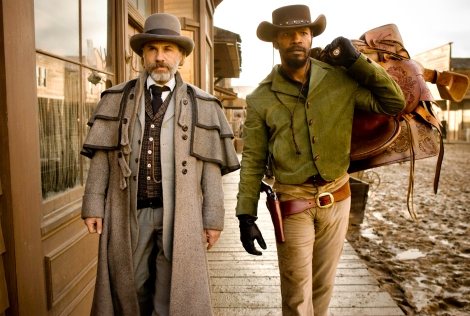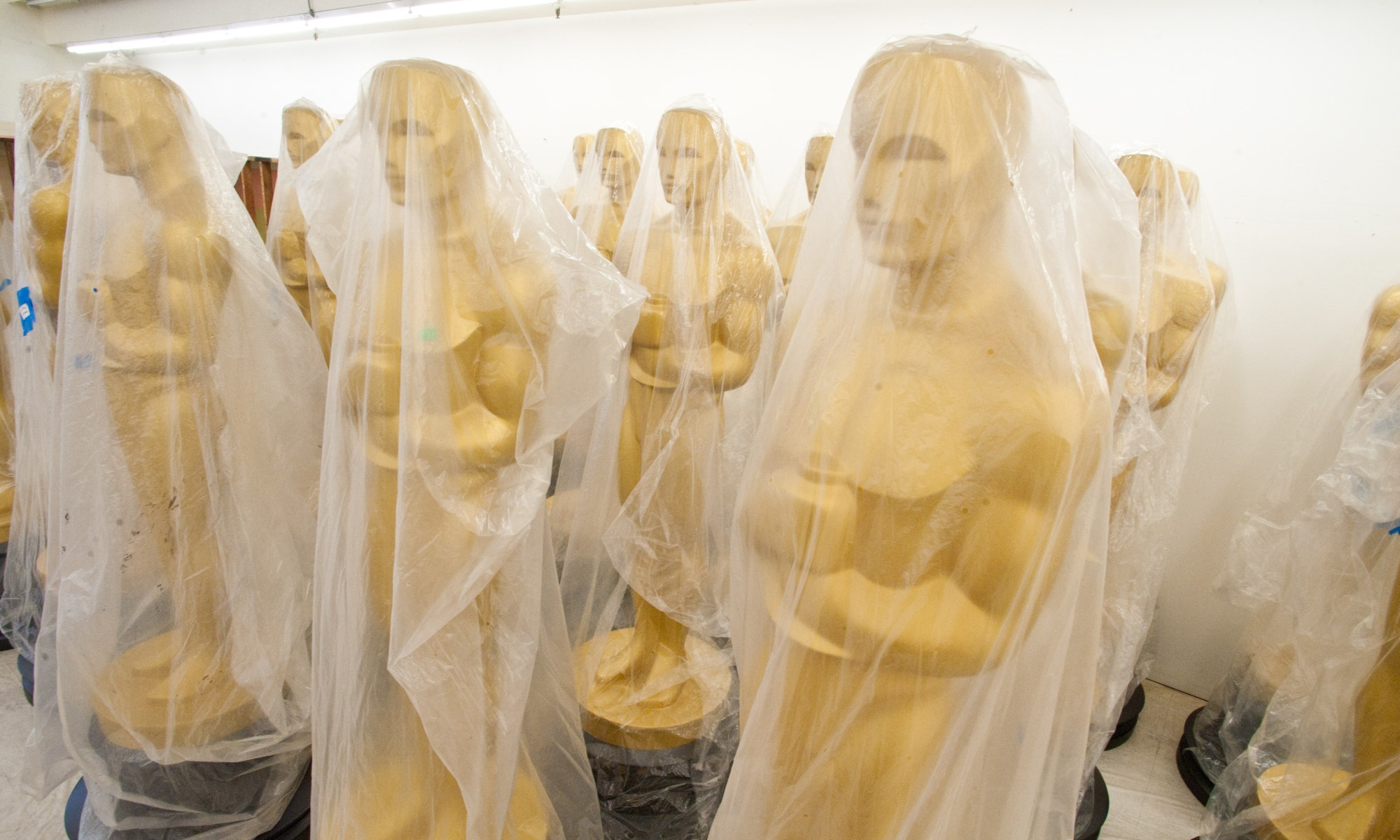The last in a three-part series in which AwardsLine breaks down all nine of the best picture contenders.

Django Unchained
What the Academy says: 5 nominations (Picture: Stacey Sher, Reginald Hudlin, Pilar Savone; Supporting Actor: Christoph Waltz; Original Screenplay: Quentin Tarantino; Cinematography: Robert Richardson; Sound Editing: Wylie Stateman)
What the public says: $147.5M domestic boxoffice; $111.5M international (as of Feb. 1)
What Pete Hammond says: Quentin Tarantino’s spaghetti-western homage was a Christmas Day release and struggled just to meet its late-year release date. That means its five nominations including best picture are an impressive feat considering many members probably didn’t get a chance to see it because of the earlier voting schedule. It just shows the love for all things Tarantino, as this is the third film for which the director has seen a best picture nom. Although unlike Inglourious Basterds and Pulp Fiction, Tarantino didn’t earn a best director nomination this year. However, along with Michael Haneke for Amour, he’s a frontrunner for original screenplay for this wild and somewhat controversial mashup of cowboys and slaves. It has little chance to prevail as best picture, but because it’s now certified as Tarantino’s biggest boxoffice hit to date, that probably doesn’t matter.
What other awards say: 2 Golden Globes for supporting actor Christoph Waltz and Tarantino’s screenplay, 1 CCMA win for original screenplay, 5 BAFTA noms, and a PGA nom.
What the critics say: “What Tarantino has is an appreciation for gut-level exploitation film appeal, combined with an artist’s desire to transform that gut element with something higher, better, more daring. His films challenge taboos in our society in the most direct possible way, and at the same time, add an element of parody or satire… The film is often beautiful to regard. Tarantino’s Southern plantations are flatlands in spring, cloud-covered, with groups of slaves standing as figures in a landscape.”—Roger Ebert, The Chicago Sun-Times
What the producer says: “When Quentin made Reservoir Dogs, he realized that some people didn’t know they were allowed to laugh. When he made Pulp Fiction, Quentin said he needed to let the audience in on the joke,” explains Stacey Sher. “That’s the reason why humor is a part of his work, because that’s how you can take the dramatic underpinnings of everything that he’s doing that are profound and emotional and that take you on the journey. There’s always romance in Quentin’s films, whether it’s unrequited like Mia Wallace and Vincent Vega or even cartoony like Pumpkin and Honey Bunny in Pulp Fiction, and ultimately all of the stuff that has been subtexted in his movies, in these great love stories, is text in Django’s quest to find his Broomhilda. So he mixes these things. These are the colors in his tool kit. They’re sophisticated, they’re surprising and allow you to go on his journey that includes things that are rough.”
What the filmmaker says: “I was never stirred by how much I put the N-word in my script,” Tarantino said at this year’s Golden Globes. “If someone out there is saying I use it more in my movie than it was used in the Antebellum South, well, feel free to make that case. But no one is making that case. They’re saying I should lie, whitewash and massage (my script), and I don’t do that when it comes to my characters. I’m more concerned about the slavery in America: The drug laws that put more blacks in jail than they did in the ’70s, the prisoners that are traded back and forth between public and private prisons — that’s straight-up slavery.”

Zero Dark Thirty
What the Academy says: 5 nominations (Picture: Mark Boal, Kathryn Bigelow, Megan Ellison; Lead Actress: Jessica Chastain; Original screenplay: Mark Boal; Film Editing: William Goldenberg, Dylan Tichenor; Sound Editing: Paul N.J. Ottosson)
What the public says: $71.8M domestic boxoffice; $7.7M international (as of Feb. 1)
What Pete Hammond says: When Zero Dark Thirty started the season off by winning one major critics award after another, it appeared that it could have unstoppable momentum all the way to the Academy Awards. After all, this film was the followup project for the Oscar-winning The Hurt Locker team of director Kathryn Bigelow and screenwriter Mark Boal. And Sony Pictures had a strong release plan, opening it slowly, building awards and word of mouth, and then going wide the day after Oscar nominations. Unfortunately, controversy reared its ugly head with a trio of powerful U.S. senators and the acting head of the CIA all criticizing the film for its depiction of torture as a device used to ultimately capture and kill Osama bin Laden. The studio and the filmmakers were slow to respond and defend their film, although they eventually did come out swinging. Then the Academy’s director’s branch, as they did with Ben Affleck and Tom Hooper, surprisingly snubbed Bigelow, who was thought to be a certain nominee for her remarkable work. Although the film got five key nominations, its momentum from the critics awards slowed. Though star Jessica Chastain won at the Globes and Critics Choice, and the boxoffice was extremely strong when it finally went wide, its inevitability as a major best picture threat seemed questionable. But it is a crazy year, and another chapter might still be written for Zero Dark Thirty, especially if voters feel big government is trying to roll over artists.
What other awards say: 5 BAFTA noms, 2 CCMAs for best actress Chastain and film editing, 1 Golden Globe win for Chastain, , as well as DGA, and WGA noms.
What the critics say: “Zero Dark Thirty is a puzzle that keeps changing and re-forming; we’re held by fleeting references, by the workings of Maya’s calculations. Bigelow and the cinematographer, Greig Fraser, make fluid but firm use of a handheld camera, without excessive agitation, so that you feel pitched into the middle of things but also see clearly what you need to see. A sequence in which a Jordanian who may provide access to bin Laden approaches an American military installation is drawn out to a level of almost unendurable suspense. Two unexpected bomb explosions throw you back in your seat; they have a ferocious power that makes most movie explosions feel like a mere perturbation of digits.”—David Denby, The New Yorker
What the producer says: “I didn’t want to play fast and loose with history,” says Boal, “and I wanted to track as closely as I could with what was known of the intelligence hunt and hopefully bring together all these disparate pieces of information. But you’re compressing 10 years into two hours, so that’s where all the normal things that movies do to compress time were things that I did, and you’re also trying to dramatize events to tell a story most effectively. That doesn’t mean the events aren’t true, it just means you’re making them as dramatic as you possibly can.”
What the filmmaker says: “It’s not just the modern military genre (I’m attracted to), but also it’s the topicality that I find really riveting and galvanizing,” Bigelow says. “(Boal) was certainly reporting this story as it was unfolding, and there’s a kind of urgency and timeliness to that. And at the same time, I think we both felt a responsibility to tell it in a certain way, to tell it responsibly and to be faithful to the research.”

Beasts of the Southern Wild
What the Academy says: 4 nominations (Picture: Dan Janvey, Josh Penn, Michael Gottwald; Directing: Benh Zeitlin; Lead Actress: Quvenzhané Wallis; Adapted Screenplay: Lucy Alibar, Behn Zeitlin)
What the public says: $11.7M domestic boxoffice
What Pete Hammond says: This is definitely the little indie movie that could. Debuting only a year ago at the Sundance Film Festival where it won the Grand Jury Prize, few would have guessed that it would become such a major Oscar player just one year later with nominations for best picture, adapted screenplay, director, and lead actress for its 9-year-old star, Quvenzhané Wallis. It is clearly a Cinderella story for this unusual film and a feather in the cap for Sundance as well as Fox Searchlight, which picked up the film and ran with it. As the only best picture nominee to come from the first nine months of the year, it also stands out as the beneficiary of a passionate support base in the Academy. However, like last year’s Searchlight nominee, The Tree of Life, the love probably stops with the nomination, but it could triumph the day before at the Independent Spirit Awards.
What other awards say: 4 Cannes Film Festival awards (FIPRESCI Prize, Golden Camera, Prix Regards Jeune, and Ecumenical Jury), 2 Sundance Film Festival wins (cinematography, Grand Jury Prize), 4 Indie Spirit noms, 1 CCMA win for Wallis as best young actor/actress, and 1 BAFTA nom for adapted screenplay.
What the critics say: “Played by Quvenzhané Wallis, an untrained sprite who holds the camera’s attention with a charismatic poise that might make grownup movie stars weep in envy, Hushpuppy is an American original, a rambunctious blend of individualism and fellow feeling. In other words, she is the inheritor of a proud literary and artistic tradition, following along a crooked path traveled by Huckleberry Finn, Scout Finch, Eloise (of the Plaza), Elliott (from E.T.), and other brave, wild, imaginary children. These young heroes allow us, vicariously, to assert our innocence and to accept our inevitable disillusionment when the world falls short of our ideals and expectations.”—A.O. Scott, The New York Times
What the producer says: “The premise was a challenge from the get-go, and we weren’t backed by a major studio. We made it with Cinereach, a nonprofit that is challenging the world with the movies they’re putting out. We went in saying, ‘We want to make a movie with a 6-year-old who’s never acted before and put her opposite someone who’s never acted before.’ And Cinereach said, ‘Yes, that’s the miracle of the movie,’ ” says Gottwald.
What the filmmaker says: “When we shot the last scene between Quvenzhané Wallis and Dwight Henry,” says Zeitlin, “when both actors had to cry—they were first-time actors, so they didn’t have years of training to know how to just switch on the waterworks, so we all had to work together at that moment to make it happen. And then I was crying, the cameraman was crying, the boom operator was crying, the producers were crying—we all put ourselves in the mindset of losing a parent, and when I got the take, it was that moment where I knew we had gotten the film.”

